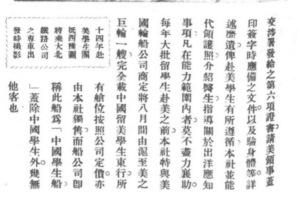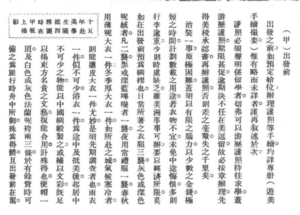 Excerpt 1. the exclusivity of passengers1
Excerpt 1. the exclusivity of passengers1
 Excerpt 2. The instruction of the dress code2
Excerpt 2. The instruction of the dress code2
Yajun Mo, in his chapters, posits that the Chinese Tourism Service Limited (CTS) assumed the responsibility of managing and transporting Chinese international students to the United States in response to the demands of the nationalist government. CTS was tasked with various responsibilities, including finding accommodations, helping international students register for school, managing education funds, and sending report cards to their parents, all aimed at maintaining their ties with ethnic roots in China.3. This played a role in cultivating a nationalist sentiment among international students. However, according to the primary source discussed in this blog, it argues that CTS not only contributed to the construction of nationalist sentiment but also actively promoted the concept of Chineseness by establishing an exclusive spatial identity for Chinese international students. In creating this distinct identity, CTS differentiated Chinese students from foreigners during their journey to the US. Also, CTS provided instructions to international students on how to dress appropriately in the US.
The primary source for this blog is an article published by CTS in 1927 in the magazine 旅行雜誌. The blog presents select critical excerpts from this article to illustrate the key argument.
To promote the idea of Chineseness, CTS set Chinese international students apart from foreigners during their sea journey to the United States. As mentioned in Excerpt 1, CTS arranged an exclusive ship solely for the travel of Chinese international students, avoiding their mingling with other foreign passengers. That is, “本社特與美國輪船公司商定 … 巨輪一艘。完全載中國留美學生東行。… 而船公司即稱此船為“中國留學生船”蓋除中國學生外。幾無他客也。”4 Despite the international nature of the journey, operated by foreign entities, these international students acquired an exclusive spatial identity within the confines of the ship. On the one hand, they engaged with the global community by adopting Western transportation and benefited from international business to facilitate their travels abroad. On the other hand, their activities were restricted to their original social circle. While they could leverage foreign technologies, their interaction with the authentic foreign community was limited, given their exclusive status within the ship. What began as an international journey evolved into a trip without immediate contact with foreigners and with limited participation in foreign cultures.
Concerning lifestyle instructions, CTS played a pivotal role in guiding the dress code for international students. In Excerpt 2, CTS emphasised the importance of bringing traditional Chinese-style clothing that could authentically showcase the Chinese identity within the foreign community, thereby creating exclusivity around the clothes of Chinese students. The authors note, “日常所著之衣物三襲。灰色或深色呢絨者。凡二襲。黑或深藍陽啜者一襲,”5 wherein CTS recommended specific colours for everyday wear, elevating these colours to symbols of Chinese-exclusive clothing. In this foreign space, the chosen colours became distinctive representations of exoticism. Notably, CTS highly recommended the inclusion of clothing made from Chinese silk, intended to “以揚東方名貴之文藝,”5 solidifying the Chinese identity through the choice of materials. In this case, materials became symbolic representations of identity, establishing a standardised image of a Chinese in a foreign environment. From the prescribed colours to the emphasis on Chinese-produced materials, CTS reinforced the Chineseness of these students by instituting a set of lifestyle norms for Chinese international students in American society. While these students studied abroad, immersing themselves in foreign cultures and visiting iconic American sites such as Yellowstone National Park as noted by Mo in his chapter,6 they were simultaneously restrained by the directives of their home country’s agency—CTS. CTS constructed an ideal image of being Chinese in a foreign space, blending the students’ spatial identity with foreign influences and a distinctly Chinese traditional foundation.
In essence, the foreign journey for Chinese international students was not merely an educational pursuit but also a reinforcement of Chineseness. CTS, through its involvement in their study abroad experience, not only provided students with benefits but also underscored their Chinese identity by establishing an exclusive space on the ship. Individually, CTS instructed the students’ lifestyle in the United States, promoting a traditional Chinese dress code in style and material. While these international students benefitted from a foreign education, the journey fortified their identity within the community. Consequently, the tourism experience for Chinese international students carries profound implications for constructing Chineseness within overseas Chinese communities.
Primary Sources
Zhuang Jiuzhu 庄九铸, Xu Zhaofeng 许兆丰, “Zengbie Youmei Xuesheng” 赠别游美学生, 旅行雜誌 (1927): 86–96.
Secondary Sources
Mo, Yajun, Touring china: A history of travel culture, 1912-1949 (Ithaca, 2022).
- Zhuang Jiuzhu 庄九铸, Xu Zhaofeng许兆丰 “Zenbie Youmei Xuesheng” 赠别游美学生, Luxing Zazhi 旅行雜誌 (1927): 87. [↩]
- Zhuang Jiuzhu and Xu Zhaofeng, ‘Zenbie Youmei Xuesheng’, p. 88. [↩]
- Yajun Mo, Touring China: A History of Travel Culture, 1912-1949 (Ithaca, 2022), p. 36. [↩]
- Zhuang Jiuzhu and Xu Zhaofeng, ‘Zenbie Youmei Xuesheng’, p. 87. [↩]
- Ibid. [↩] [↩]
- Mo, Touring China, p. 36. [↩]